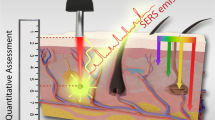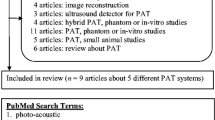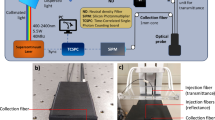Abstract
Purpose
The aim of the study was to determine the feasibility of using a clinical optical breast scanner with molecular imaging strategies based on modulating light transmission.
Procedures
Different concentrations of single-walled carbon nanotubes (SWNT; 0.8–20.0 nM) and black hole quencher-3 (BHQ-3; 2.0–32.0 µM) were studied in specifically designed phantoms (200–1,570 mm3) with a clinical optical breast scanner using four wavelengths. Each phantom was placed in the scanner tank filled with optical matching medium. Background scans were compared to absorption scans, and reproducibility was assessed.
Results
All SWNT phantoms were detected at four wavelengths, with best results at 684 nm. Higher concentrations (≥8.0 µM) were needed for BHQ-3 detection, with the largest contrast at 684 nm. The optical absorption signal was dependent on phantom size and concentration. Reproducibility was excellent (intraclass correlation 0.93–0.98).
Conclusion
Nanomolar concentrations of SWNT and micromolar concentrations of BHQ-3 in phantoms were reproducibly detected, showing the potential of light absorbers, with appropriate targeting ligands, as molecular imaging agents for clinical optical breast imaging.




Similar content being viewed by others
References
Gibson AP, Hebden JC, Arridge SR (2005) Recent advances in diffuse optical imaging. Phys Med Biol 50:R1–R43
Ntziachristos V, Chance B (2001) Probing physiology and molecular function using optical imaging: applications to breast cancer. Breast Cancer Res 3:41–46
Tromberg BJ, Shah N, Lanning R et al (2000) Non-invasive in vivo characterization of breast tumors using photon migration spectroscopy. Neoplasia 2:26–40
Peters NH, Borel RI, Zuithoff NP, Mali WP, Moons KG, Peeters PH (2008) Meta-analysis of MR imaging in the diagnosis of breast lesions. Radiology 246:116–124
Raza S, Chikarmane SA, Neilsen SS, Zorn LM, Birdwell RL (2008) BI-RADS 3, 4, and 5 lesions: value of US in management—follow-up and outcome. Radiology 248:773–781
Pisano ED, Gatsonis C, Hendrick E et al (2005) Diagnostic performance of digital versus film mammography for breast-cancer screening. N Engl J Med 353:1773–1783
Yeh E, Slanetz P, Kopans DB et al (2005) Prospective comparison of mammography, sonography, and MRI in patients undergoing neoadjuvant chemotherapy for palpable breast cancer. AJR Am J Roentgenol 184:868–877
Leff DR, Warren OJ, Enfield LC et al (2008) Diffuse optical imaging of the healthy and diseased breast: a systematic review. Breast Cancer Res Treat 108:9–22
Godavarty A, Thompson AB, Roy R et al (2004) Diagnostic imaging of breast cancer using fluorescence-enhanced optical tomography: phantom studies. J Biomed Opt 9:488–496
Corlu A, Choe R, Durduran T et al (2007) Three-dimensional in vivo fluorescence diffuse optical tomography of breast cancer in humans. Opt Express 15:6696–6716
van de Ven S, Wiethoff A, Nielsen T et al (2009) A novel fluorescent imaging agent for diffuse optical tomography of the breast: first clinical experience in patients. Mol Imaging Biol 12:343–348
Zavaleta CL, Smith BR, Walton I et al (2009) Multiplexed imaging of surface enhanced Raman scattering nanotags in living mice using noninvasive Raman spectroscopy. Proc Natl Acad Sci USA 106:13511–13516
Ntziachristos V, Yodh AG, Schnall M, Chance B (2000) Concurrent MRI and diffuse optical tomography of breast after indocyanine green enhancement. Proc Natl Acad Sci USA 97:2767–2772
Intes X, Ripoll J, Chen Y, Nioka S, Yodh AG, Chance B (2003) In vivo continuous-wave optical breast imaging enhanced with indocyanine green. Med Phys 30:1039–1047
Cuccia DJ, Bevilacqua F, Durkin AJ et al (2003) In vivo quantification of optical contrast agent dynamics in rat tumors by use of diffuse optical spectroscopy with magnetic resonance imaging coregistration. Appl Opt 42:2940–2950
De la Zerda A, Zavaleta C, Keren S et al (2008) Carbon nanotubes as photoacoustic molecular imaging agents in living mice. Nat Nanotechnol 3:557–562
Intes X (2005) Time-domain optical mammography SoftScan: initial results. Acad Radiol 12:934–947
Ntziachristos V, Chance B (2001) Accuracy limits in the determination of absolute optical properties using time-resolved NIR spectroscopy. Med Phys 28:1115–1124
Vernon ML, Freachette J, Painchaud Y, Caron S, Beaudry P (1999) Fabrication and characterization of a solid polyurethane phantom for optical imaging through scattering media. Appl Opt 38:4247–4251
Mincu N, Brunette J, Guilman O et al (2008) Diffuse optical tomography and spectroscopy performance assessment: phantoms and methodology. In: Nordstrom RJ (ed) Design and performance validation of phantoms used in conjunction with optical measurements of tissue, 1st edn. SPIE, San Jose, pp 68700O–68700O-10
Contini D, Martelli F, Zaccanti G (1997) Photon migration through a turbid slab described by a model based on diffusion approximation. I. Theory. Appl Opt 36:4587–4599
Arridge SR, Schweiger M (1997) Image reconstruction in optical tomography. Philos Trans R Soc Lond B Biol Sci 352:717–726
Black Hole Quencher® Dyes. Biosearch Technologies Inc. Novato, CA. http://www.biosearchtech.com/support/applications/dyes-from-biosearch-technologies/black-hole-quencher%C2%AE-dyes. Accessed 19 Feb 2010
Kam NW, O’Connell M, Wisdom JA, Dai H (2005) Carbon nanotubes as multifunctional biological transporters and near-infrared agents for selective cancer cell destruction. Proc Natl Acad Sci USA 102:11600–11605
Carney PA, Miglioretti DL, Yankaskas BC et al (2003) Individual and combined effects of age, breast density, and hormone replacement therapy use on the accuracy of screening mammography. Ann Intern Med 138:168–175
Boyd NF, Guo H, Martin LJ et al (2007) Mammographic density and the risk and detection of breast cancer. N Engl J Med 356:227–236
Mincu N, Djeziri S, Ichalalene Z, Leblond F, Khayat M (2007) Sensitivity and repeatability of diffuse optical tomography: towards breast cancer neoadjuvant treatment monitoring. In: Chance B, Alfano RR, Tromberg BJ, Tamura M, Sevick-Muraca EM (eds) Optical tomography and spectroscopy of tissue VII, 1st edn. SPIE, San Jose, pp 64341D–64349D
Godavarty A, Eppstein MJ, Zhang C, Sevick-Muraca EM (2005) Detection of single and multiple targets in tissue phantoms with fluorescence-enhanced optical imaging: feasibility study. Radiology 235:148–154
Weissleder R, Ntziachristos V (2003) Shedding light onto live molecular targets. Nat Med 9:123
Schipper ML, Nakayama-Ratchford N, Davis CR et al (2008) A pilot toxicology study of single-walled carbon nanotubes in a small sample of mice. Nat Nanotechnol 3:216–221
Debbage P, Jaschke W (2008) Molecular imaging with nanoparticles: giant roles for dwarf actors. Histochem Cell Biol 130:845–875
Acknowledgments
This work was supported, in part, by funding from ART Advanced Research Technologies Inc., National Cancer Institute (NCI) In Vivo Cellular Molecular Imaging Center (ICMIC) grant P50 CA114747 (SSG), NCI Center of Cancer Nanotechnology Excellence (CCNE) CA119367 U54, and the Canary Foundation. We also thank Adam de la Zerda for helpful discussions.
Author information
Authors and Affiliations
Corresponding author
Electronic supplementary materials
Below is the link to the electronic supplementary material.
Supp. Fig. 1
Average absorption measurements at 732 nm of phantoms of three sizes (200, 780, and 1,570 mm3) containing six concentrations of SWNTs (0.8, 1.6, 2.4, 4, 6.4, and 20 nM). Error bars represent the standard deviation of duplicate measurements. (GIF 19 kb)
Supp. Fig. 2
Average absorption measurements at 781 nm of phantoms of three sizes (200, 780, and 1,570 mm3) containing six concentrations of SWNTs (0.8, 1.6, 2.4, 4, 6.4, and 20 nM). Error bars represent the standard deviation of duplicate measurements. (GIF 27 kb)
Supp. Fig. 3
Average absorption measurements at 827 nm of phantoms of three sizes (200, 780, and 1,570 mm3) containing six concentrations of SWNTs (0.8, 1.6, 2.4, 4, 6.4, and 20 nM). Error bars represent the standard deviation of duplicate measurements. (GIF 29 kb)
Supp. Fig. 4
Average absorption measurements at 732 nm of phantoms of two sizes (200 and 780 mm3) containing five concentrations of BHQ-3 (2.0, 4.0, 8.0, 16, and 32 µM). Error bars represent the standard deviation of duplicate measurements. (GIF 26 kb)
Supp. Fig. 5
Average absorption measurements at 781 nm of phantoms of two sizes (200 and 780 mm3) containing five concentrations of BHQ-3 (2.0, 4.0, 8.0, 16, and 32 µM). Error bars represent the standard deviation of duplicate measurements. (GIF 20 kb)
Supp. Fig. 6
Average absorption measurements at 827 nm of phantoms of two sizes (200 and 780 mm3) containing five concentrations of BHQ-3 (2.0, 4.0, 8.0, 16, and 32 µM). Error bars represent the standard deviation of duplicate measurements. (GIF 20 kb)
Supp. Table 1
Dependency of optical absorption signal (y) on SWNT/BHQ-3 concentration (x) for each phantom size and wavelength. (RTF 32 kb)
Rights and permissions
About this article
Cite this article
van de Ven, S.M.W.Y., Mincu, N., Brunette, J. et al. Molecular Imaging Using Light-Absorbing Imaging Agents and a Clinical Optical Breast Imaging System—a Phantom Study. Mol Imaging Biol 13, 232–238 (2011). https://doi.org/10.1007/s11307-010-0356-3
Published:
Issue Date:
DOI: https://doi.org/10.1007/s11307-010-0356-3




